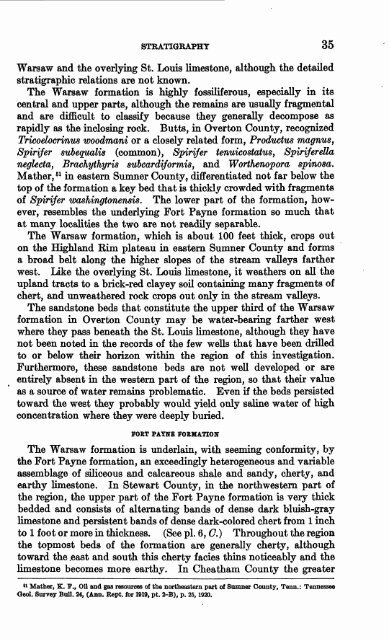GROUND WATER IN NORTH-CENTRAL TENNESSEE
GROUND WATER IN NORTH-CENTRAL TENNESSEE
GROUND WATER IN NORTH-CENTRAL TENNESSEE
You also want an ePaper? Increase the reach of your titles
YUMPU automatically turns print PDFs into web optimized ePapers that Google loves.
STRATIGRAPHY 35<br />
Warsaw and the overlying St. Louis limestone, although the detailed<br />
stratigraphic relations are not known.<br />
The Warsaw formation is highly fossiliferous, especially in its<br />
central and upper parts, although the remains are usually fragmental<br />
and are difficult to classify because they generally decompose as<br />
rapidly as the inclosing rock. Butts, in Overton County, recognized<br />
Tricoelocrinus woodmani or a closely related form, Productus magnus,<br />
Spirifer subequalis (common), Spirifer tenuicostatus, Spiriferetta<br />
neglecta, Brachythyris subcardiformis, and Worthenopora spinosa.<br />
Mather, 51 in eastern Sumner County, differentiated not far below the<br />
top of the formation a key bed that is thickly crowded with fragments<br />
of Spirifer washingtonensis. The lower part of the formation, how<br />
ever, resembles the underlying Fort Payne formation so much that<br />
at many localities the two are not readily separable.<br />
The Warsaw formation, which is about 100 feet thick, crops out<br />
on the Highland Rim plateau in eastern Sumner County and forms<br />
a broad belt along the higher slopes of the stream valleys farther<br />
west. Like the overlying St. Louis limestone, it weathers on all the<br />
upland tracts to a brick-red clayey soil containing many fragments of<br />
chert, and unweathered rock crops out only in the stream valleys.<br />
The sandstone beds that constitute the upper third of the Warsaw<br />
formation in Overton County may be water-bearing farther west<br />
where they pass beneath the St. Louis limestone, although they have<br />
not been noted in the records of the few wells that have been drilled<br />
to or below their horizon within the region of this investigation.<br />
Furthermore, these sandstone beds are not well developed or are<br />
entirely absent in the western part of the region, so that their value<br />
as a source of water remains problematic. Even if the beds persisted<br />
toward the west they probably would yield only saline water of high<br />
concentration where they were deeply buried.<br />
FORT PAYNE FORMATION<br />
The Warsaw formation is underlain, with seeming conformity, by<br />
the Fort Payne formation, an exceedingly heterogeneous and variable<br />
assemblage of siliceous and calcareous shale and sandy, cherty, and<br />
earthy limestone. In Stewart County, in the northwestern part of<br />
the region, the upper part of the Fort Payne formation is very thick<br />
bedded and consists of alternating bands of dense dark bluish-gray<br />
limestone and persistent bands of dense dark-colored chert from 1 inch<br />
to 1 foot or more in thickness. (See pi. 6, (7.) Throughout the region<br />
the topmost beds of the formation are generally cherty, although<br />
toward the .east and south this cherty facies thins noticeably and the<br />
limestone becomes more earthy. In Cheatham County the greater<br />
« Mather, K. F., Oil and gas resources of the northeastern part of Sumner County, Tenn.: Tennessee<br />
Oeol. Survey Bull. 24, (Ann. Kept, for 1919, pt. 2-B), p. 25,1920.

















